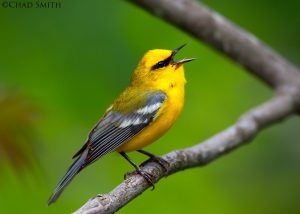Those who know me well, know that I am an avid birdwatcher. My older brothers got me started when I was just a kid. And when I say just a kid, I mean that – I started birding when I was seven. For Christmas just before my ninth birthday, my brother Jim created a whole set of life lists and year list templates (before templates were really a thing) and bound them in a notebook. Totally geeky, right? To this day, it remains one of the best presents anyone has ever given me.
I bring all of this up because we are now in the middle of spring migration, when the forests of North America become a byway for returning songbirds heading north to their breeding grounds. Yes, there are migrations for other types of birds as well – certain species of hawks return to our area in the spring, as do shorebirds. But for those birds fall migration is the more significant event. Spring migration is all about birds from the neotropics.

Warblers, tanagers, orioles, certain grosbeaks (Rose-breasted and Blue), flycatchers, thrushes vireos. These are among the most colorful and beautiful birds we see in the States. Brilliant yellows and oranges, deep reds, stunning blues. Many of the birds have gorgeous songs – the thrushes in particular. Most of the migrants are very small; the warblers tend to be only four or five inches from beak to tail. And many of them hang out at the very top of the forest canopy, making them very difficult to spot, much less identify, and leading to an avocational malady known as “warbler neck,” which is pretty much self-explanatory.
For serious birders, spring migration is New Year’s, Mardi Gras, and the Fourth of July all rolled into one. I know that it is my favorite time of the year and I am pleased to say that despite the pandemic, it is something I have been able to enjoy fully this spring. Every morning I walk a few miles on a rails-to-trails path near my home. I get a bit of exercise, and I see my favorite birds. Just about every day I am reminded of a birding experience from my childhood, of a moment with my brothers or an early sighting while alone that convinced me I could identify species on my own. For me, spring migration is about more than seeing the birds. It is about reconnecting with nature, and also with a passion that has remained with me for literally half a century. It is about memory and family. It both calms and invigorates me. A single good sighting on my morning walk can buoy my mood for the entire day.
As a kid, I was self-conscious about my interest in birds. A few of my closest friends knew, but otherwise I kept it to myself, fearing that I would be teased. I was already a nerd. I was short. I wasn’t the best athlete. I was usually in the school play. So already I had a lot of geek cred. The birdwatching, I feared, would be one nerd-attribute too many. Looking back on this, I regret how shy I was in this regard. It has always been so important to me. And yet, even to this day, I feel a twinge of embarrassment when I’m out with binoculars in hand, searching the foliage for a warbler or wren, and someone I know happens past. Old habits die hard.
On the other hand, I once had someone ask me for an interview what my superpower was. And the truth is, my superpower is that I can identify by song almost any bird native to my area. I’m sitting outside as I write this, and just in the moment I pause in my typing I can hear a Red-eyed Vireo, a Blue-gray Gnatcatcher, a Carolina Chickadee, a Tufted Titmouse, a Summer Tanager, a House Finch, and a Nashville Warbler. Yeah, I know – as superpowers go, it’s not much. But really it’s all I’ve got.
In any case, I wasn’t sure what to write about today, and given how much of a balm birding has been for me these past few weeks, I thought I would share this.
For those who are interested, birding is an easy hobby to pick up and a rewarding one to pursue. All you need is a pair of binoculars, a good field guide, and a willingness to learn.
Wishing you all a wonderful week.








